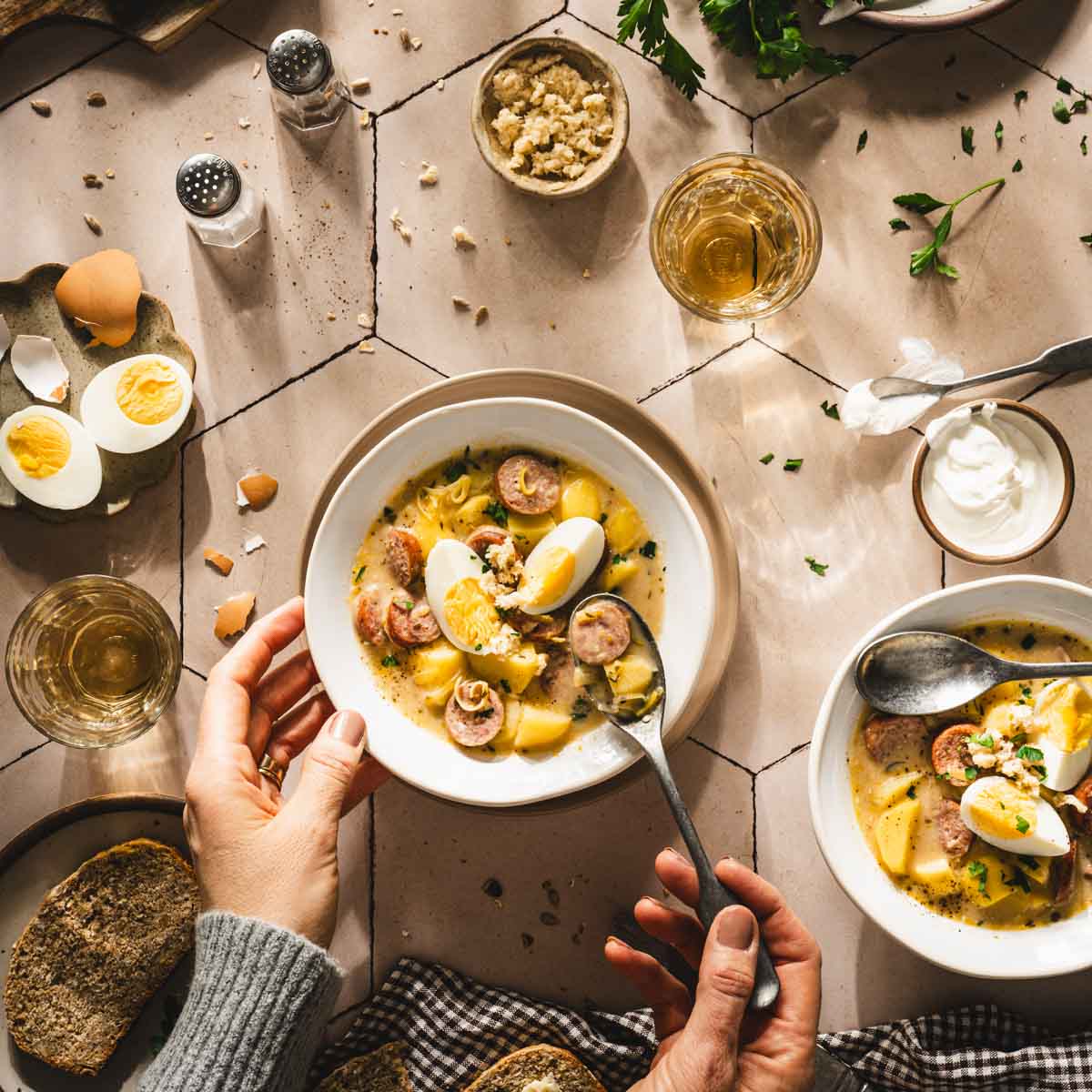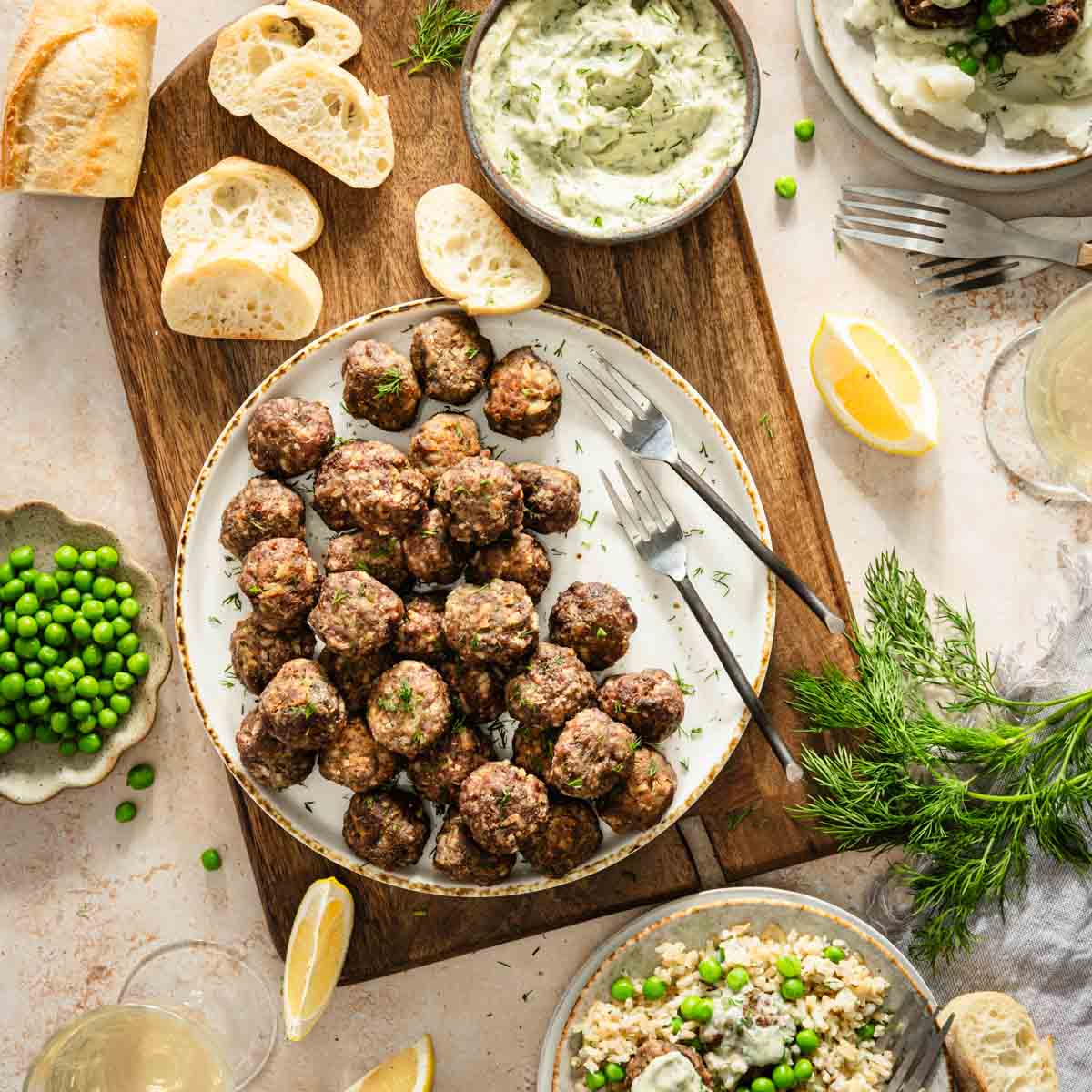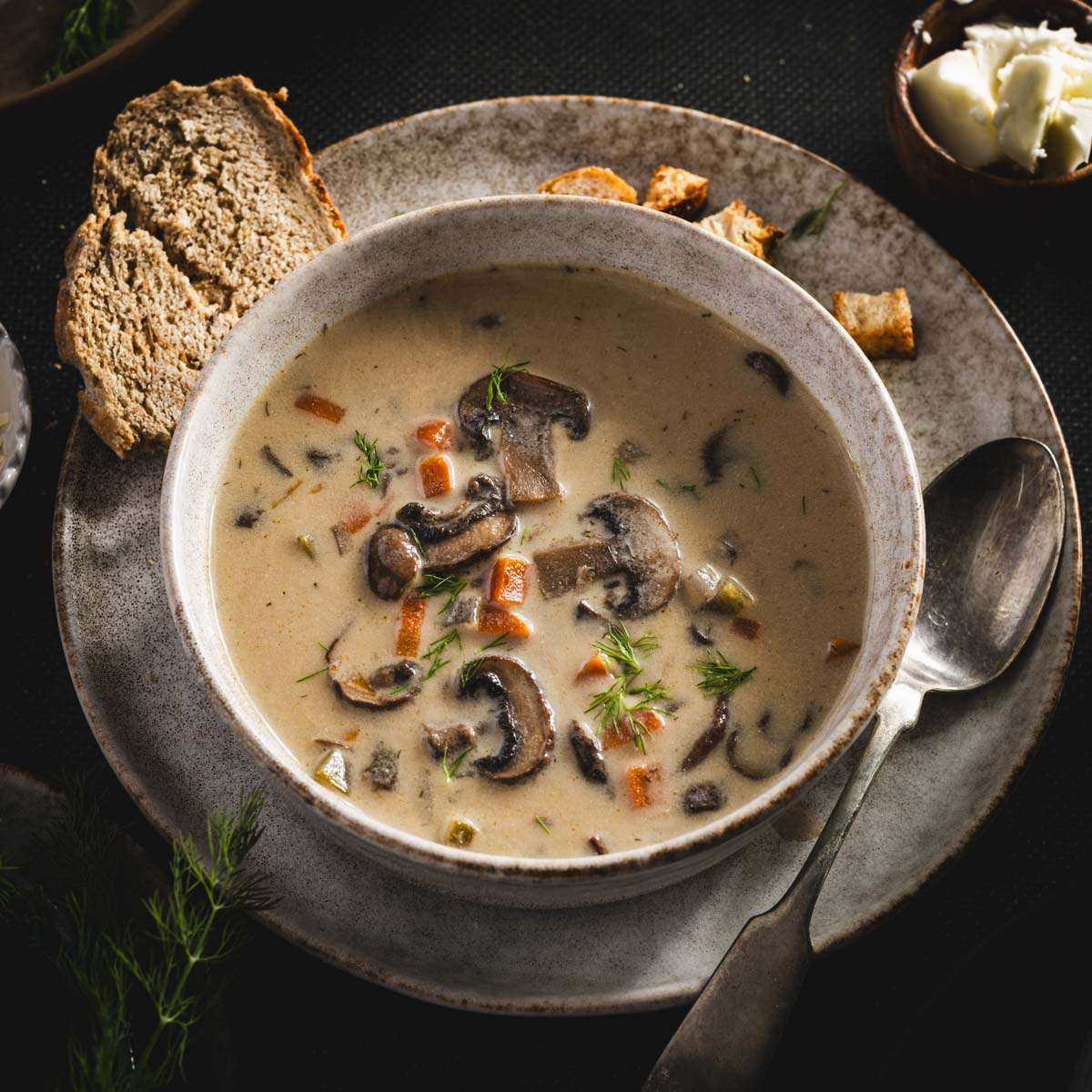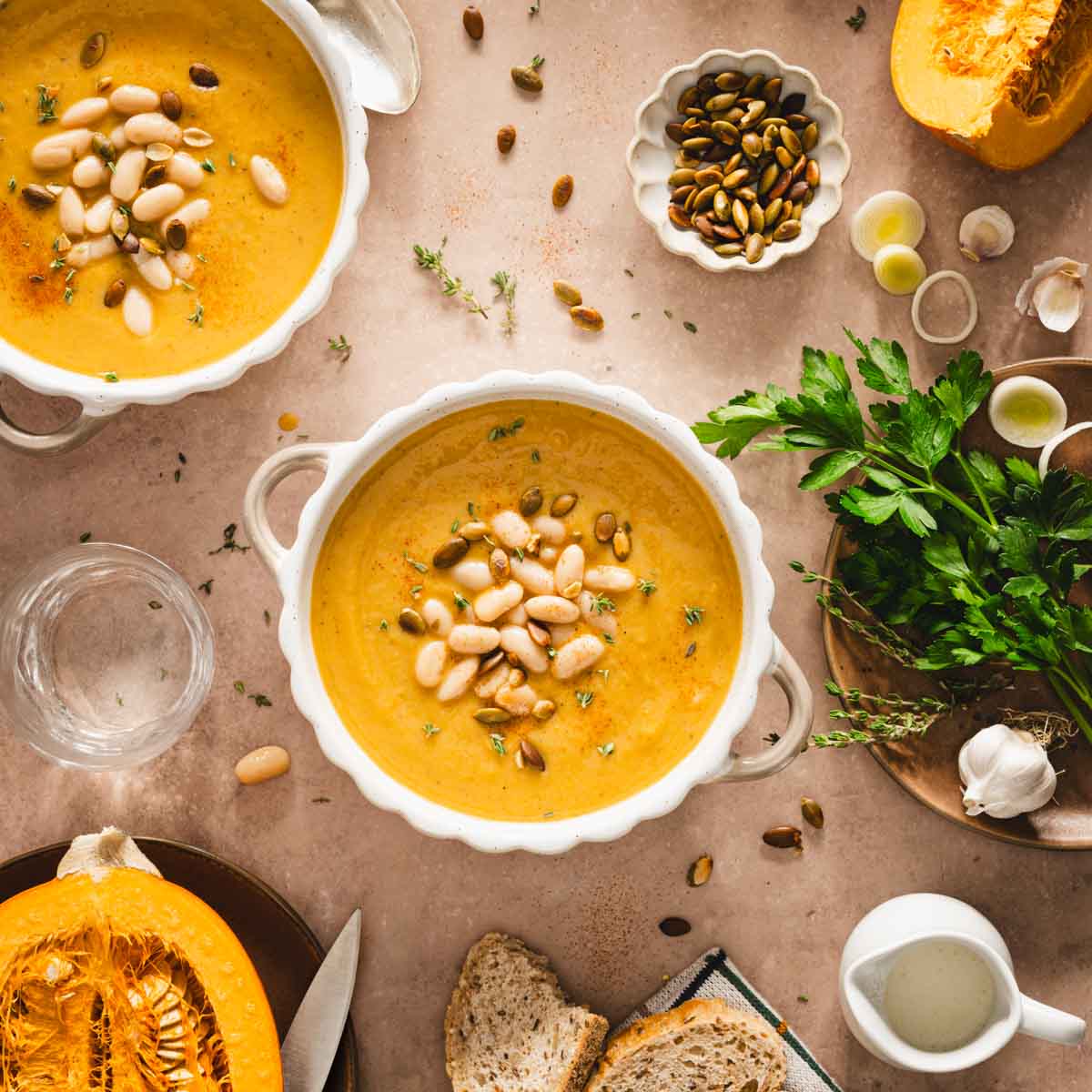Delicious Salmon Soup with fresh dill – Zupa Rybna
Tender salmon, delicate aromatics, and a touch of tangy mustard, sounds delicious, right?
This Polish-inspired Creamy Salmon soup is perfect for Lent, Easter, or simply when craving a comforting soup.

This fish soup starts with a simple homemade stock infused with leeks, onions, and warm spices like bay leaf and allspice. Adding cream gives it a luscious texture, while mustard and capers add a gentle punch of flavor.
Whether you’re looking for a new way to enjoy salmon or want to bring a little Polish-inspired comfort to your table, this soup is sure to become a favorite. Let’s dive into how to make it!
Why you will love this recipe
It’s rich but not heavy – the creamy broth feels indulgent, but the fish keeps it light.
Fresh salmon makes it feel special – a step up from your everyday soup, perfect for Lent or Easter.
Classic Polish flavors with a twist – dill, leeks, mustard, and capers create a beautifully balanced, slightly tangy taste.
Comfort in a bowl – it’s cozy, warming, and satisfying, yet easy to make.
Ingredients, Variations and Substitutions


Salmon is the star here, bringing rich, buttery flavor to the soup. Ideally, go for fresh whole fish or fish fillets, but if you only have frozen, thaw them properly before use. If salmon isn’t an option, trout or Arctic char will give a similar texture and taste, while white fish like cod or halibut will work for a lighter alternative.
Leeks are my go-to. They add a subtle sweetness and melt beautifully into the broth. If you don’t have leeks, shallots, or a mild yellow onion, slice them finely so they don’t overpower the soup. Use unsalted butter or olive oil to gently saute them.
For the liquid, a good fish broth (or fish stock cubes) takes this soup to the next level, but if you don’t have it, no worries! Simmering water with vegetables (leeks green parts, parsnip, parsley root or stems), scraps and aromatics like bay leaves, peppercorns can create a quick, flavorful alternative. You can also use vegetable stock, but keep an eye on the salt level, as store-bought versions vary.
For the creamy element, heavy cream gives the soup its signature velvety texture. If you prefer something lighter, half-and-half works, and for a dairy-free version, go with full-fat coconut milk—it adds a slightly different vibe but keeps things deliciously smooth.
Capers and Dijon mustard – they might not be traditional, but they add a beautiful tanginess that enhances the fish without overwhelming it. If capers aren’t your thing, try a small amount of chopped green olives for a similar briny punch, or simply increase the mustard for extra depth.
Finally, no Polish-inspired soup is complete without plenty of fresh dill. If you’re out, parsley or even a bit of tarragon can add a fresh note, but honestly, dill is the way to go for that perfect finish.
Use salt and black pepper to taste.


Equipment you will need
- Large pot or Dutch oven.
- Fine-mesh strainer
- Large soup pot
- Cutting board & sharp knife
- Wooden spoon or spatula
- Ladle
- Small bowl & whisk (optional)

Top Tips
Let the broth simmer long enough – don’t rush the broth-making step. Let it simmer for 15-20 minutes to extract all the flavors. This will create a richer, more flavorful base for your soup.
Be gentle with the salmon – when adding the salmon, poach it gently in the simmering soup to keep it tender and flaky. The salmon can become tough if the soup is at a rolling boil. Keep the heat low to avoid overcooking the fish!
Taste as you go – taste the soup after adding the mustard, capers, and cream. If it needs a little brightness, add a splash of lemon juice. If it’s too tangy, adjust with a pinch of sugar.
Use fresh dill at the end – fresh dill adds a burst of flavor, but you want to add it after you take the soup off the heat to preserve its brightness. This way, it’ll retain its freshness without wilting.
Keep the cream smooth – when adding cream or sour cream, stir it in off the heat to keep it from curdling. If you’re using sour cream, you can temper it first by mixing a little hot broth into it before adding it to the soup. This step helps keep the texture velvety.
Don’t rush the potatoes – allow the potatoes to cook until they’re fork-tender before adding the salmon. They’ll absorb the flavors of the broth, making the soup extra delicious.
Adjust the seasoning – because the broth and salmon have natural flavors, you’ll want to taste for salt and black pepper at the end. Capers can add some saltiness, but you may still need a little extra seasoning to get that perfect balance.
Step-by-step instructions
- In a medium pot, add water, bay leaf, allspice berries, onion, leek tops, parsley stems, carrot peels, potato peels, parsnips, and salt.
- Bring to a boil, then reduce heat and simmer for 15-20 minutes to develop flavor.



- Strain out all the solids and discard them, keeping only the clear broth.
- Prepare the salmon. Run your fingers along the fillet to check for any pin bones. If you find any, remove them using tweezers or kitchen pliers.
- If your fillet has skin and you prefer a smoother texture in the soup, use a sharp knife to remove the salmon skin carefully. Hold it firmly and slice between the flesh and skin at a slight angle.
- Cut the salmon into bite-sized chunks (about 1-inch pieces) for the best texture. This helps it cook evenly in the soup and prevents it from breaking apart too much.
- Melt butter (or olive oil) in a skillet over medium heat.
- Add the sliced leeks and carrots, sautéing for 3-5 minutes until soft and fragrant.



- Transfer them to the pot with homemade broth, then add the potatoes, bay leaf, and black peppercorns.
- Bring to a gentle boil, then reduce to a simmer and cook for 10-12 minutes, until the potatoes are fork-tender.



- Add the salmon chunks to the soup and let them poach gently for 5-7 minutes, until they turn opaque and flake easily with a fork.



- Stir in the mustard and capers, then mix in the heavy cream.
- Let everything warm for 2-3 minutes, but don’t let it boil to keep the cream smooth.
- Remove from heat and stir in lemon juice and fresh dill. Taste and adjust seasoning with salt and pepper.
- Serve hot, garnished with extra dill and a drizzle of cream, with crusty bread on the side.
Best ways to enjoy this soup
Serve it fresh & hot – this soup is at its absolute best when served right after cooking, while the salmon is perfectly tender and the flavors are fresh.
Pair it with a thick slice of rye bread (classic Polish choice!) or a crusty sourdough.
Add a little extra cream & more fresh herbs.
Enjoy with a light side – if you want to make it a full meal, a simple cucumber salad with a light vinaigrette or a shaved fennel salad will balance the richness of the soup.

You may also like:
Storage instructions, reheating
To keep this salmon soup tasting fresh, let it cool to room temperature before storing, but don’t leave it out for more than 2 hours.
- Refrigeration: transfer the soup to an airtight container and store it in the fridge for up to 3 days. Since it contains fish and dairy, it’s best enjoyed fresh.
- Freezing: this soup does not freeze well due to the cream. Freezing can cause it to separate, and the salmon may become grainy. If you plan to freeze it, set some aside before adding the cream, then stir it in after reheating. Store the broth and salmon separately in a freezer-safe container for up to 2 months.
Reheating Tips
- Stovetop (Best Method): pour the soup into a pot and reheat gently over low to medium heat, stirring occasionally. Avoid boiling, as it can make the salmon tough and cause the cream to separate. If it thickens too much, stir in a splash of broth, water, or extra cream to loosen it up.
- Microwave: heat in short 30-second bursts, stirring in between, until warmed through. Use a lower power setting to prevent overheating the fish.
- From Frozen: if you froze the broth separately, thaw it in the fridge overnight, then warm it on the stove before adding fresh cream and reheating gently.


Delicious Salmon Soup with fresh dill – Zupa Rybna
Equipment
- Large soup pot or Dutch oven
- fine mesh strainer
- cutting board & sharp knife
- wooden spoon, spatula
- Small bowl, whisk
- skillet
Ingredients
For the broth
- 4 cups water
- 1 bay leaf
- 5-6 allspice berries
- ½ small onion
- 1 leek green tops
- a few parsley stems
- peels from the carrots and potatoes
- 1 parsnip
- ½ tsp salt
For the soup
- 1 tbsp butter or neutral oil
- 1 leek white and light green parts only, thinly sliced into rounds
- 2 carrots peeled and diced
- 3-4 small potatoes peeled and cubed
- 1 bay leaf from earlier
- ½ tsp black peppercorns
- 12 oz fresh salmon skin removed, cut into chunks
- 1 tsp Dijon or whole-grain mustard
- 1 tbsp capers drained and chopped
- ½ cup heavy cream or sour cream
- 1 tbsp lemon juice or to taste
- 2 tbsp fresh dill chopped
- Salt and black pepper to taste
Instructions
- In a medium pot, add water, bay leaf, allspice berries, onion, leek tops, parsley stems, carrot peels, potato peels, parsnips, and salt.
- Bring to a boil, then reduce heat and simmer for 15-20 minutes to develop flavor.
- Strain out all the solids and discard them, keeping only the clear broth.
- Prepare the salmon.
- Run your fingers along the fillet to check for any pin bones. If you find any, remove them using tweezers or kitchen pliers.
- If your fillet has skin and you prefer a smoother texture in the soup, use a sharp knife to carefully remove the salmon skin. Hold it firmly and slice between the flesh and skin at a slight angle.
- Cut the salmon into bite-sized chunks (about 1-inch pieces). This helps it cook evenly in the soup and prevents it from breaking apart too much.
- In a clean skillet, melt butter (or olive oil) over medium heat.
- Add the sliced leeks and carrots, sautéing for 3-5 minutes until soft and fragrant.
- Transfer them into the pot with homemade broth, then add the potatoes, bay leaf, and black peppercorns.
- Bring to a gentle boil, then reduce to a simmer and cook for 10-12 minutes, until the potatoes are fork-tender.
- Add the salmon chunks to the soup and let them poach gently for 5-7 minutes, until they turn opaque and flake.
- Stir in the mustard and capers, then mix in the heavy cream.
- Let everything warm for 2-3 minutes, but don’t let it boil to keep the cream smooth.
- Remove from heat and stir in lemon juice and fresh dill. Taste and adjust seasoning with salt and pepper.
- Serve hot, garnished with extra dill and a drizzle of cream, with crusty bread on the side.
Notes
Nutrition
Did you make this recipe?
Tag me @sylwiavaclavekphotography or tag me using #myomnikitchen so I can see your creations! You can also leave a comment below!
Conclusion
This creamy, easy Salmon Soup offers comfort, nutrition, and layers of flavor from fresh herbs, vegetables, and aromatics.
This soup will become a family favorite whether you’re making it for Easter, on Christmas Eve, or just as a cozy meal during busy weeknights.


FAQ
What can I use instead of heavy cream?
For a lighter option, you can use half-and-half or even full-fat coconut milk for a dairy-free twist. Greek yogurt (stirred in at the end) also works, but avoid boiling after adding it to prevent curdling.
My soup turned out too thick—how can I fix it?
Simply stir in a bit more broth, water, or even a splash of milk until you reach your desired consistency.
What if I don’t have fresh dill?
Dried dill can work in a pinch. Use about ⅓ of the amount since it’s more concentrated. You can also swap in parsley or chives for a different herbal note.
Is this Salmon soup gluten-free?
Yes, as long as you don’t serve it with bread that contains gluten. If thickening the soup, use a gluten-free option like cornstarch instead of flour.
Can I add more vegetables?
Absolutely! Root vegetables like sweet potatoes or turnips are fantastic additions, and even bell peppers would blend well with the creamy broth. Just adjust the cooking times.








I don’t know why I didn’t make it sooner. This soup is so delicious. The lightly poached salmon is tender and falling apart, while the cream gives it a smooth finish. The homemade broth is perfect for this soup. It’s so quick to make. It’s definitely a keeper.